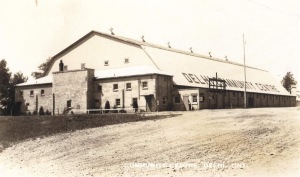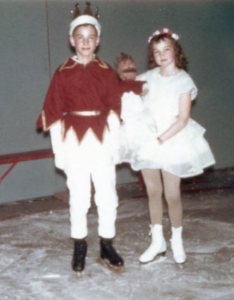The Delhi arena was our community center. It housed our public skating in winter and summer, our hockey teams, our figure skaters, our bike races, wrestling matches and the odd magic show. But chief among its attractions was the Ice Carnival, that happened every March.
Small towns like Delhi enjoy a trait you can’t find in a big city: togetherness. The Ice Carnival brought together hundreds of parents, children, fans, performers, business leaders, round-the-corner store owners, and just as many more contributors who worked tirelessly in the background, unknown to many of us as they mobilized for this annual event.
The Delhi Figure Skating Club put on the Ice Carnival. This was the capstone to four months of figure skating instruction. Youngsters would show up every Wednesday afternoon to learn the basics of skating. They scrabbled over weak ankles and catchy toe picks that tripped them every time they moved. Yet four months later, they had mastered forwards, backwards, modest hops and skips, and skating hand in hand with their groups. The Intermediate and Senior skaters appeared on Wednesday and Saturday evenings, and had learned or polished their ability to execute spins and mid-air jumps, dances in pairs and precise figures.
All of these accomplishments were the fulfillment of many parents’ dreams of one day seeing their child be the next Karen Magnussen or Toller Cranston. But in the short term, they would be happy just to see them applauded as a star on ice, and that’s what the carnival promised.
Every year the DFSC would choose a theme. Maybe one time it was Peter Pan, or Wizard of Oz. The musical Gypsy was nominated one year. Other times it was Deep In The Heart of Texas, Nutcracker and Aladdin. The theme became the platform for choosing characters which might be Munchkins, or gum drops, Tinkerbell, scarecrows, clowns, broncos, cowgirls, roughnecks, roses, skunks, elephants, pink panthers, candy canes, Belles of The Ball, you name it.
The carnival ignited a war effort of volunteerism. The juniors show would require possibly 200 costumes. And for each of these, a mother would get a pattern which might be for a teddy bear, to be sewn in three segments. If she couldn’t deliver, there were sewing dynamos who were skater mothers like Jackie Byron, Hazel Osborne, Yvonne Kelleher, Georgette Rapai, Marjorie Klein who would bang out ten teddy bear costumes, or fifteen skunks with stuffed tails, as long as you brought the material.
The theme was rounded out with backdrop and props. Moms and dads would show up to staple 40-inch tin foil around the entire boards of the rink, and string electric lights. Under the direction of Gord Franklin, sheets of plywood and lengths of 2x4s would appear, and were pounded into scenery walls across the back end of the rink. Teams of painters would arrive with buckets of tempera to draw forests, and houses, and oil wells, windmills and whimsical street scenes.
Truly, if there were 200 skaters in the carnival, there were 200 parents who helped sew, paint, build and deliver. One year we required 30 tambourines for a big number. With some ingenuity Cy Stapleton acquired enough steel pie plates into which he cut and welded flattened, perforated bottle caps that rattled raucously. Not quite symphonic, but still impressive.
The music was key for the Ice Carnival. Under the direction of Floyd Thomas, the Delhi Band would practise and perform perhaps 20 different tunes and bumper segments to bring our solos, dances and parades to life.
Meanwhile at the business end of the production, every skater was assigned a group of tickets to sell. These challenges were as daunting as a walk to the principal’s office. Neighbourhoods were canvassed door-to-door by mumbling, addled urchins with handfuls of card-sized tickets, going for $2,$3,$4 each. We were exhorted to get them all sold, or don’t come home.
As the day approached, dress rehearsals were convened, and under the stressful din of our instructors we were given our routines. The Juniors were herded in groups of ten or fifteen. Their performance consisting of a couple tours around the ice, perhaps a rotating ring or parade of bunny hops. The more accomplished were picked to do solos. The soloists usually got exclusive costumes with more colors or frills or trim. They were stars.
The intermediates and seniors had more complex routines to maneuver and there were more opportunities for truly gifted skaters to create and perform solos and duets, showing off impressive turns, spins, jumps and speed. They looked special, and the crowds loved them.
There were always a few dance numbers. A dozen or more seniors would waltz around the ice while the band played. The Averys, a very senior and elegant visiting couple would skate the equivalent of a ballroom dance, dressed in tails and evening gown. They glided around the rink, gracefully, classy, smiling and wowing the audience with their apparent ease on ice.
Ice Carnivals also provided comic humour, and the few remaining senior guys, Paul and George Rapai, Skip Lumley, Mike Byron, Chris Brown, Rob Lammens, contributed. The crowds enjoyed their romps in weird cow costumes, throwing confetti into the bleachers, riding steel wash buckets, pedaling two-seated bicycles backwards on tacked tires, skipping rope and lassoing each other.
One legacy of the Ice Carnival was its famous precision line. While most of us at the time did not know of the Rockettes, it was certainly the model after which the senior girls and ladies were instructed. Thirty or more would appear in stunning short-skirted outfits, embellished with ruffles, ribbon, sequins and gloves to dazzle the crowd with powerful confident moves in unison, rocking and skating to the up tempo sounds from the band. They circled, counter-circled, wiggled and swayed, and finally lined up to deliver a jaw-dropping kick line forwards and backwards. The precision team became a show piece in the region for years after under the direction of Karen Haskins.
All of these things are indelibly etched in my memory for the years that I participated. The experience of putting on a show, the excitement and tension of huddling behind a backdrop, surrounded by giggling groups of pretty girls, goofy guys dressed in party gear and faces smeared in grease paint, lipstick and Nivea cold creme like Mardi Gras, waiting for a cue…and the music would start up, the lights dimmed, the spots went on, out we went, and the crowds would cheer… it was a special time.
Thanks for reading and sharing! I hope you too remember a special time when you were down at the rink!















Hi again. In the first picture I can’t put a name to the clown between you and John Harrison. Paul Earhardt is beside John H. I think that must be Paul Rapai in the back row. I see you and Bunny and Nancy Lasko in several pictures. Thanks for renewing more childhood memories.
Brian
>
LikeLiked by 1 person
Hi Brian! I am sorry, but I don’t recognize him either! Maybe someone else will remember this fellow.
LikeLike
Brother Wayne reminded me he played records for the DFC for at least two years on Wednesdays and Saturdays . He asked what your brother is doing and where he lives.
Brian
>
LikeLike